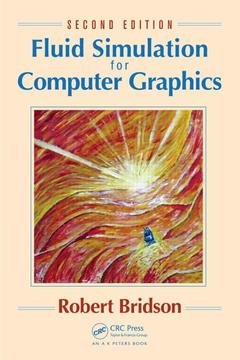Fluid Simulation for Computer Graphics (2nd Ed.)
Auteur : Bridson Robert

A practical introduction, the second edition of Fluid Simulation for Computer Graphics shows you how to animate fully three-dimensional incompressible flow. It covers all the aspects of fluid simulation, from the mathematics and algorithms to implementation, while making revisions and updates to reflect changes in the field since the first edition.
Highlights of the Second Edition
- New chapters on level sets and vortex methods
- Emphasizes hybrid particle?voxel methods, now the industry standard approach
- Covers the latest algorithms and techniques, including: fluid surface reconstruction from particles; accurate, viscous free surfaces for buckling, coiling, and rotating liquids; and enhanced turbulence for smoke animation
- Adds new discussions on meshing, particles, and vortex methods
The book changes the order of topics as they appeared in the first edition to make more sense when reading the first time through. It also contains several updates by distilling author Robert Bridson?s experience in the visual effects industry to highlight the most important points in fluid simulation. It gives you an understanding of how the components of fluid simulation work as well as the tools for creating your own animations.
THE BASICS. The Equations of Fluids. Overview of Numerical Simulation. Advection Algorithms. Level Set Geometry. Making Fluids Incompressible. Smoke. Particle Methods. MORE TYPES OF FLUIDS. Water. Fire. Viscous Fluids. MORE ALGORITHMS. Turbulence. Shallow Water. Ocean Modeling. Vortex Methods. Coupling Fluids and Solids. Background. Derivations.
Date de parution : 10-2015
15.2x22.9 cm
Thème de Fluid Simulation for Computer Graphics :
Mots-clés :
Computer graphics; Equations of fluids; Fluid equations; Fluid simulation; Incompressible flow; Incompressible fluids; Particle methods; Visual effects; CFL Condition; Vortex methods; Si Unit; Divergence Free Velocity Field; CFL Number; Variable Viscosity Fluids; Intermediate Velocity Field; PDE Form; Fast Marching Method; Linear PDE; Solid Wall Boundary Conditions; Free Surface Boundary Condition; Vice Versa; Mac Grid; Moving Contact Line; semi-Lagrangian Advection; Height Field; Grid Cell; Skew Symmetric Part; Pressure Solve; Solid Velocities; Vortex Particles; Incompressible Euler Equations; Immersed Boundary Method; semi-Lagrangian Method; Vorticity Variation
